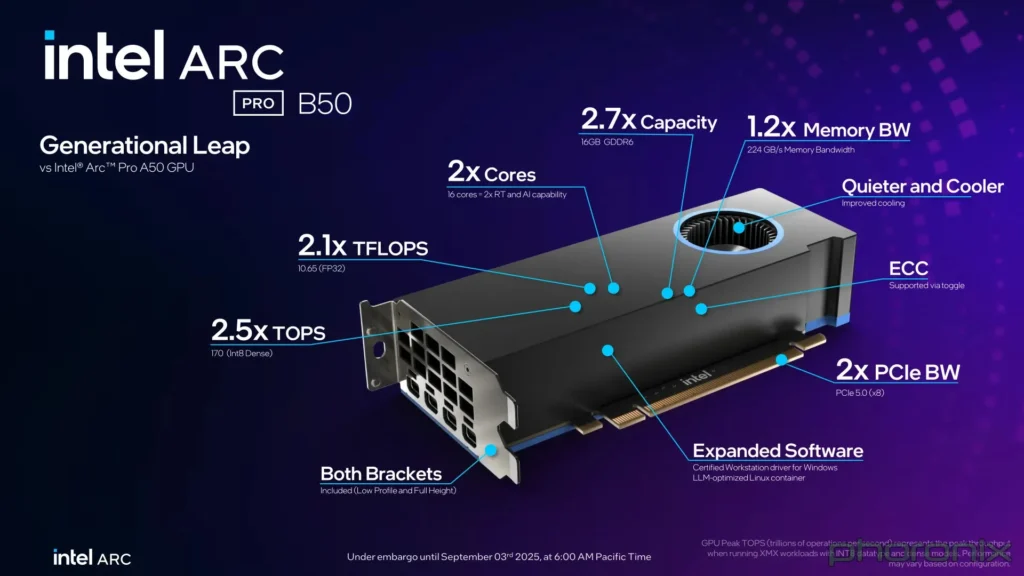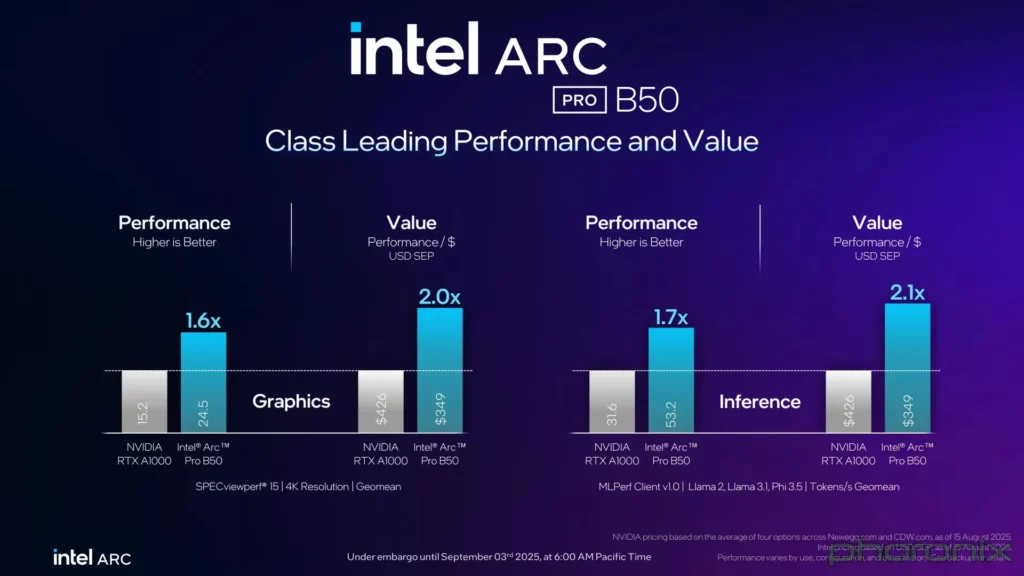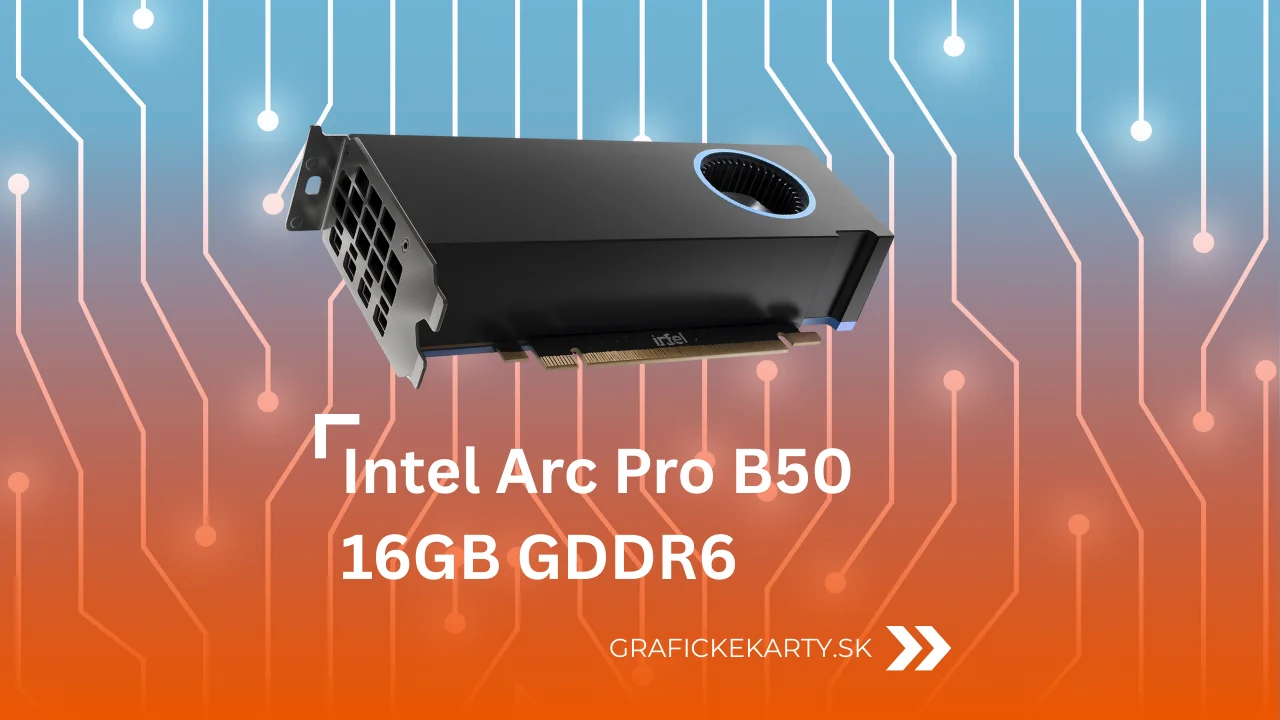The Intel Arc Pro B50 enters the scene as an affordable yet powerful graphics card for professionals, AI developers, architects, content creators, and anyone looking for a reliable, compact, and cost-effective GPU. It builds on the advanced Battlemage architecture, offers great performance at low power, and supports local inferencing tasks – the perfect balance between price and quality. With this move, Intel is looking to strengthen its position in the professional segment while competing with long-standing giants such as NVIDIA and AMD, who have a solid customer base in this area.
Intel Arc Pro B50 design
The Intel Arc Pro B50 comes in a compact low-profile design with a dual-slot construction, making it a great fit for smaller SFF workstations. Both a low-profile and standard bracket (a metal bracket that mounts the card to the case and provides connectors to the PC’s back panel) are included, so the card fits seamlessly into a variety of case types. The back offers four mini DisplayPort outputs that allow you to connect multiple monitors at once – a handy solution for graphic designers, engineers or users working on multiple projects simultaneously. Its compact size will also be appreciated by businesses that need to easily expand performance across multiple setups without major hardware or infrastructure modifications.
Intel Arc Pro B50 cooling
The Intel Arc Pro B50 is extremely power-efficient with a TDP of just 70W, which means it doesn’t need any additional power connectors – it takes all of its power directly from the PCIe slot. This approach reduces power requirements while simplifying installation. Thanks to the low power consumption, a simple active cooling system is sufficient to keep the card at acceptable temperatures even under prolonged loads.
The dual-slot design ensures better airflow in the case and reduces the risk of overheating. Although it is not a massive cooler with multiple fans, the efficiency of the entire design is enough to maintain stable performance. In practice, this means that the card operates quietly, reliably and with minimal temperature fluctuations.
Importantly for more demanding users, stable temperatures also contribute to longer component life and less wear and tear. This makes the Intel Arc Pro B50 an attractive solution for the office, studio and smaller workstations where a combination of quiet operation and stability is key.
Technical Specifications
Built on the Battlemage architecture, the Intel Arc Pro B50 combines low power consumption with surprisingly high performance. It is equipped with 16GB of modern GDDR6 memory, which is double that of many competing models at a similar price point. It’s the large memory coupled with optimized throughput that ensures smooth operation when editing video, working with 3D models, or running demanding AI applications.
The graphics core achieves a boost frequency of up to 2600 MHz along with a 128-bit memory bus, providing enough performance for everyday tasks and professional use. The result in tests is also interesting: the card outperforms older Arc Pro models by more than 40% in synthetic benchmarks, showing that this is a real shift in performance. Compared to the slightly more powerful Arc B570, it lags behind by about a fifth, but it’s still great value for money.
Support on Linux platforms is also a strength of the card. It is already compatible with modern distributions upon release and brings features like SR-IOV or multi-GPU scaling, which will be appreciated by more advanced users and companies deploying GPUs in multiple builds. There’s also 170 TOPS of inference performance, which is key for local AI job processing.
Complete Intel Arc Pro B50 specification table
| Technical Specifications | Intel Arc Pro B50 |
|---|---|
| Chip | NVIDIA GeForce RTX 5080 |
| Architecture | Battlemage (Xe2, BMG-G21) |
| Boost frequency | 2600 MHz |
| Number of Xe2 cores | 16 |
| Memory size | 16 GB GDDR6 |
| VRAM | 14 Gbps |
| Memory bus | 128-bit |
| Maximum resolution | 7680 × 4320 |
| Consumption | 70 W |
| Outputs | 4× mini DisplayPort (DP 2.1) |
| Cooling | Active (1 fan) |
| Power connector | PCIe slot only (no external connectors) |
| Recommended PSU | 280 W |
| Max. memory throughput | 224 GB/s |
| INT8 performance (inferencing) | up to 170 TOPS |
| Ubuntu support | Kernel 6.14 , Mesa 25 |
| PCIe version | PCIe Gen5 x8 |
| Dimensions/Weight | 6.61 × 2.72 inch / low-profile, dual-slot |


Availability and target audience
The Intel Arc Pro B50 comes to market with a starting price in the US of $350 making it one of the most affordable professional graphics cards in its class. It offers more memory than competitors such as the Radeon Pro W7500 or NVIDIA RTX A1000, but at a lower price.
The Intel Arc Pro B50 is built for content creators, architects, engineers, and AI developers who need reliable performance in compact form factors. It became available for pre-order in the US on September 4, 2025, with a full release date set for September 18, 2025.
Conclusion
The Intel Arc Pro B50 combines professional performance, 16GB of memory and an economical 70W TDP into a compact form factor that suits creative studios, architecture offices and AI projects. Thanks to its low price, it can appeal not only to large teams, but also to smaller companies or individuals who want a reliable card without unnecessary compromises.
If you’re looking for an affordable and stable solution for both work and modern applications, the Intel Arc Pro B50 is a choice that makes sense.
